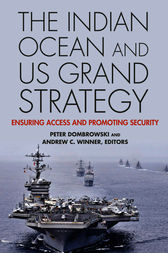|
Reviewed by Dr. Kevin E. Grimm, Assistant Professor of History, Regent University In The Indian Ocean and US Grand Strategy, the authors assembled by Peter Dombrowski and Andrew Winner use the concept of grand strategy to explore potential U.S. approaches to the Indian Ocean region. Walter Ladwig argues for a “neo-Nixon doctrine” of relative U.S. disengagement while encouraging the main democratic states of the area to adopt wider roles. Christopher Preble largely agrees and goes furthest in arguing for U.S. restraint, claiming America should “take the training wheels off” the democratic nations of the area and facilitate a more “multipolar order” in which regional powers share the security burden (p.76-77). While still advocating the importance of regional powers, Rodger Payne believes the United States should take the lead in constructing cooperative security frameworks. While he does not advocate a NATO-style organization, Payne believes America should help coordinate and facilitate cooperation on anti-proliferation, anti-terrorism, and climate change issues that will provide more economic stability and reduce the possibility of conflict by establishing international norms. Alternative to Preble and Ladwig, James Holmes and Toshi Yoshihara argue that such “offshore balancing” policies will not work in the region and instead advocate a continued American forward presence in the Indian Ocean, discussing the specifics of the herculean effort it would take to re-enter the region in the event of a major crisis occurring after disengagement. Michael Auslin essentially combines these two approaches, arguing for both “an enhanced military presence” and “a newly crafted set of overlapping and mutually reinforcing alliances, strategic partnerships, and access-granting relationships” (p. 61). In this way, Auslin argues, the U.S. presence can be sustained or even grown in the Indian Ocean region while costs are shared with new regional allies. William Martel examines the possibility of applying the containment doctrine to the region, especially regarding the growth of Chinese influence, and finds it unhelpful, not least because no common assessments of current threats to the region yet exist (p. 61). Two final chapters by Teresita Schaffer and Andrew Winner assume that current U.S. strategy will continue and assess U.S. interests and the possibility of protecting those interests. Schaffer recommends both the ongoing development of multilateral organizations as well as specific ways to combat the growing influence of Iran and China, including bilateral connections to the countries of the region more susceptible to their influence – Sri Lanka, for example. Winner takes a bit of an alternative view and suggests the United States should focus on addressing the transnational threats of terrorism, WMDs, and “various types of illegal trafficking, including in small arms and people, piracy and maritime crime at sea, and natural disasters” (p. 177). This will, he claims, both enhance regional cooperation without the risk of “exacerbating security dilemmas” and keep the United States engaged in the region at relatively low cost given budget cuts at home (p. 177). The conclusion addresses key themes, including the future roles of China and India, but on these two issues, the work might have gone further. Although a few specific Chinese actions are noted throughout, the future role of China in the region looms large. A more detailed discussion of potential Chinese strategies and goals, as much as can be gleaned from outside the People’s Republic, would have helped. In addition, the American ability to engage India in multilateral institutions and efforts, often recommended by the authors, is a sticky issue. The authors do note that India may not be interested in either a larger regional role or, more likely, in regional efforts helmed by the United States. Exploring Indian motivations more in depth or more centrally addressing what U.S. options might remain should India refuse to play an enthusiastic second in U.S.– led efforts would have helped. The options for American initiatives might then be severely curtailed. Nevertheless, the volume succeeds in presenting a series of thought-provoking questions about both the future of the U.S. presence in a region increasingly important for global trade and security and, more broadly, about the ways a democratic nation can and should address security issues and alliances in a distant part of the globe amidst anemic public enthusiasm for such engagement and the likelihood of continuing defense budget cuts. Specialists in international relations, political science, and related fields will find the theories relating to grand strategy intriguing and the discussion of multiple other issues, from terrorism to the role of international NGOs to climate change, will engage readers attracted to those topics. Finally, those interested in the Indian Ocean region in any form will find value in the volume. |


 The Indian Ocean and US Grand Strategy: Ensuring Access and Promoting Security
The Indian Ocean and US Grand Strategy: Ensuring Access and Promoting Security